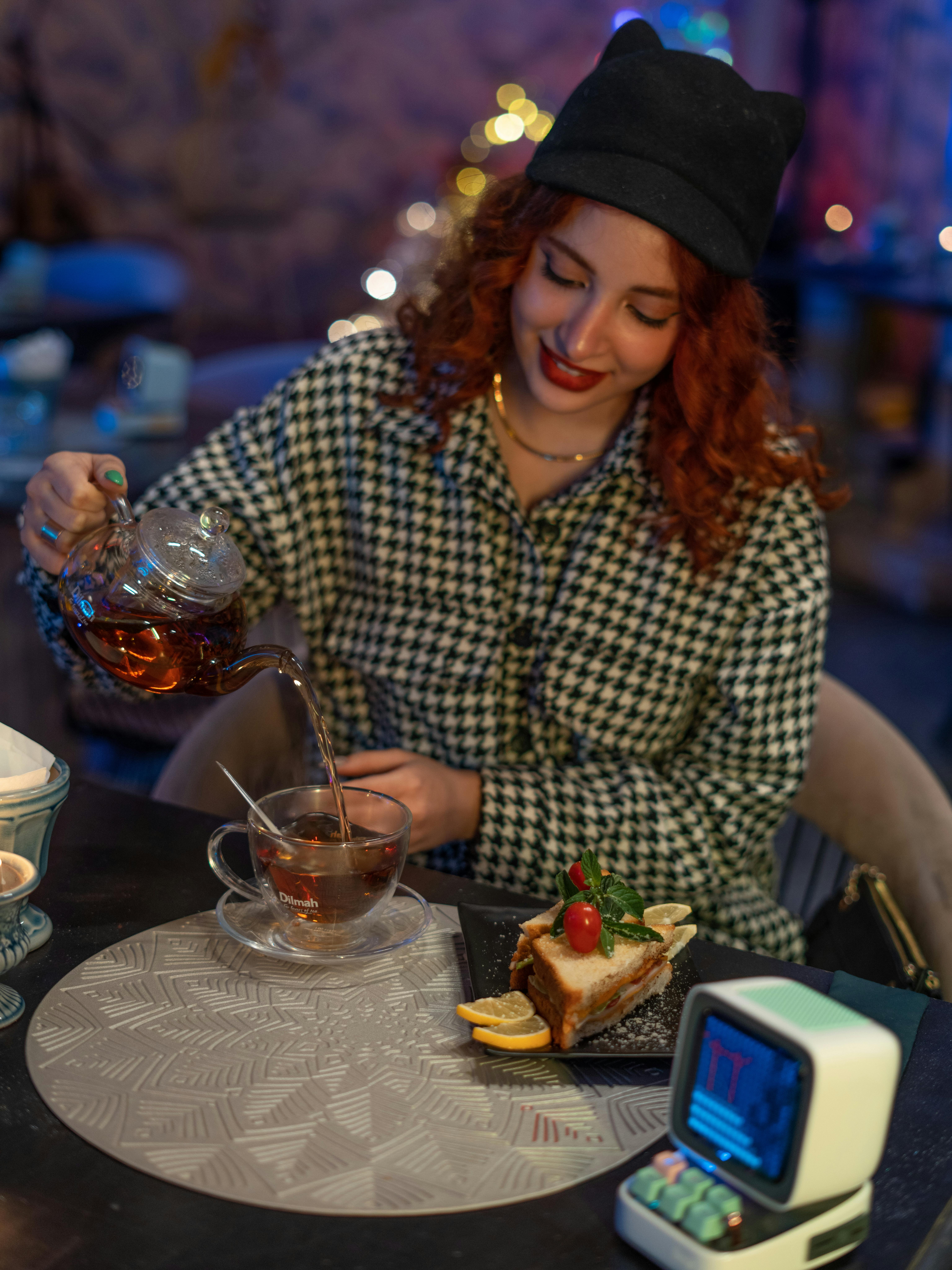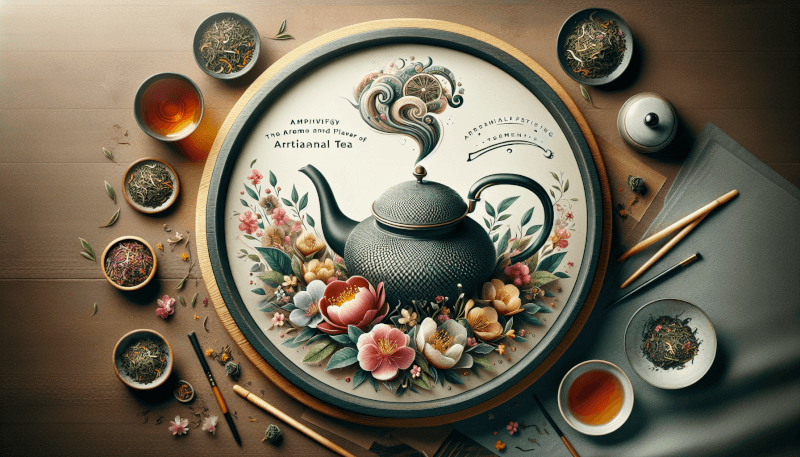Have you ever wondered how you can elevate your tea-drinking experience and truly savor the delightful aroma and flavor of specialty tea? Look no further, as we uncover the secrets to enhancing the sensory pleasure of your favorite cuppa. Whether you’re a passionate tea enthusiast or simply craving a soothing indulgence, these tips and tricks will help you unlock the full potential of your tea leaves. From brewing techniques to the perfect water temperature, get ready to embark on a flavorful journey that will take your tea drinking to new heights.

Choosing High Quality Specialty Tea
When it comes to enjoying a truly exceptional cup of specialty tea, the first step is to research the different types available. With countless varieties and flavors to choose from, it’s important to understand the nuances and characteristics of each type of tea. Take the time to learn about the different categories of specialty teas, such as green, black, white, oolong, and herbal teas. Discover the unique flavor profiles, health benefits, and brewing methods associated with each type.
After gaining a solid understanding of the various types of specialty tea, it’s crucial to select tea from reputable vendors. Look for vendors who have a strong reputation for providing high-quality teas. These vendors often source their tea directly from the growers, ensuring freshness and authenticity. By purchasing tea from a trusted vendor, you can have confidence that you are getting the best possible product.
In addition to choosing a reputable vendor, reading customer reviews can also help you in your search for high-quality specialty tea. Customer reviews offer valuable insights into the quality, taste, and overall experience of different teas. By taking the time to read reviews, you can benefit from the experiences of other tea enthusiasts and make more informed choices.
Lastly, when selecting specialty tea, consider the origin and processing method of the tea. Some tea-growing regions are known for producing exceptional teas due to their unique climate and soil conditions. Additionally, the method of processing, whether it be hand-rolling or sun-drying, can greatly impact the flavor and aroma of the tea. By considering these factors, you can further enhance your tea-drinking experience.
Proper Storage Techniques
Properly storing specialty tea is essential for preserving its freshness and flavors. Here are some important techniques to keep in mind:
Store tea in airtight containers: To protect your tea from moisture, air, and odors, store it in airtight containers. This will help maintain the tea’s quality and prevent it from absorbing any unwanted flavors.
Keep away from light, heat, and moisture: Tea is sensitive to light, heat, and moisture, which can cause it to degrade and lose its quality. Store your tea in a cool, dark place, such as a pantry or cabinet, and ensure it is away from any sources of heat or humidity.
Avoid storing near strong-smelling foods: Tea can easily absorb odors, so it’s important to keep it away from strong-smelling foods. Store your tea in a separate area to prevent any unwanted aromas from transferring onto the tea leaves.
Do not store tea in the refrigerator: While it may seem like a logical place to store tea, the refrigerator can actually be detrimental to its quality. The moisture and strong odors in the refrigerator can negatively affect the tea, compromising its taste and aroma.
By following these storage techniques, you can ensure that your specialty tea remains fresh and flavorful for an extended period.

Water Quality and Temperature
Water quality and temperature play a crucial role in the brewing process and can significantly impact the taste and aroma of your specialty tea. Here’s what you need to know:
Use filtered or spring water: High-quality water is essential for brewing the best cup of tea. Filtered or spring water is preferable as it helps remove any impurities or chlorine that can interfere with the tea’s flavor.
Ensure water is at the correct temperature for the type of tea: Different types of tea require different water temperatures to bring out their optimal flavors. For example, delicate green teas typically require cooler water around 175°F (80°C), while black teas usually require hotter water around 200°F (93°C). Refer to the specific brewing instructions for each type of tea to ensure the water temperature is appropriate.
Boil water just once to prevent loss of oxygen: When heating water for your tea, it’s advisable to only boil it once. Repeated boiling can reduce the oxygen content in the water, which can affect the taste and aroma of the tea.
Prevent water from cooling too quickly during steeping: After bringing the water to the desired temperature, pour it into the teapot or cup immediately to avoid rapid cooling. Keeping the water at the optimal temperature throughout the steeping process will ensure that the flavors and aromas are fully extracted from the tea leaves.
By paying attention to water quality and temperature, you can enhance the taste and fragrance of your specialty tea and unlock its full potential.
Measuring and Steeping Tea
To achieve the perfect cup of specialty tea, it’s important to master the art of measuring and steeping. Here are some tips to help you get it right:
Use the recommended tea-to-water ratio: Each type of tea has a specific recommended ratio of tea leaves to water. This ratio ensures that the tea is neither too weak nor too strong. Follow the guidelines provided by the tea vendor or packaging to achieve the desired flavor.
Employ a scale or measuring spoon for accuracy: For precise measurements, it’s recommended to use a scale or a measuring spoon to portion out the tea leaves. This will help maintain consistency in the strength and flavor of your brew.
Follow the recommended steeping time for each tea type: Different types of tea have varying steeping times to bring out their optimal flavors. Over-steeping can result in a bitter taste, while under-steeping may result in a weak and bland cup of tea. Refer to the brewing instructions for each type of tea and use a timer to ensure you steep for the correct duration.
Avoid over-steeping to prevent bitterness: While it’s important to steep the tea for the recommended time, be cautious not to exceed it. Over-steeping can lead to a bitter taste as the tannins in the tea are released for too long. If you prefer a stronger brew, it’s advisable to increase the amount of tea leaves rather than extending the steeping time.
By mastering the art of measuring and steeping, you can create consistently delicious cups of specialty tea that cater to your personal taste preferences.

Experimenting with Infusion Techniques
Part of the joy of specialty tea lies in the ability to experiment with different infusion techniques to create unique flavors and experiences. Here are some strategies to try:
Adjust tea quantity, strength, and steeping time to suit personal preference: Don’t be afraid to tailor the tea to your own taste. Experiment with increasing or decreasing the amount of tea leaves, adjusting the strength, and varying the steeping time to find the perfect balance that pleases your palate.
Try different brewing methods such as Western or Gongfu style: Tea can be brewed using various methods, each imparting a different taste and experience. Western-style brewing involves steeping the tea leaves directly in a teapot or infuser. Gongfu-style brewing, on the other hand, involves shorter steeping times and multiple infusions in a smaller teapot or gaiwan. Explore both methods to discover which brings out the best flavors in your tea.
Explore alternative infusers like gaiwan or mesh balls: Traditional teapots and infusers are not the only options for steeping tea. Try using alternative infusers like a gaiwan (a lidded bowl) or mesh balls to infuse your tea. These alternatives can enhance the visual and sensory experience of tea preparation.
Consider cold brewing or brewing tea with milk for unique flavors: Cold brewing tea involves steeping the tea in cold water for a longer period, resulting in a refreshing and smooth taste. Another option is to experiment with brewing tea with milk, which adds a creamy texture and new flavor dimensions to your cup of specialty tea.
By embracing experimentation, you can expand your tea-drinking horizons and discover new and exciting flavors.
Blending and Flavoring Tea
If you’re looking to add a personal touch to your specialty tea, consider blending and flavoring. Here are some ideas to enhance your tea:
Experiment with blending different teas to create unique flavors: Merge multiple teas together to create your own signature flavor profile. Mix and match various teas such as green, black, white, or herbal teas to achieve a blend that suits your taste preferences.
Add natural flavorings like herbs, fruits, or spices: Enhance the taste and aroma of your tea by adding natural flavorings. Consider incorporating herbs, fruits, or spices like mint, ginger, citrus peel, or lavender. These additions can take your tea to new levels of complexity and enjoyment.
Infuse tea with essential oils or extracts for a burst of flavor: Essential oils or extracts can provide a concentrated burst of flavor to your tea. For example, a drop of vanilla extract can transform a plain black tea into a decadent treat. Be mindful of the potency of these additions and start with small amounts to avoid overpowering the tea.
Mix in sweeteners like honey or agave syrup if desired: If you prefer a touch of sweetness in your tea, consider adding natural sweeteners like honey or agave syrup. These sweeteners can enhance the flavors of the tea without overpowering its natural taste.
By exploring various blending and flavoring techniques, you can create personalized tea blends that are tailored to your own unique preferences.
Understanding Tea Tasting Notes
To truly appreciate the nuances of specialty tea, develop an understanding of tea tasting notes. Here’s how you can enhance your tea-tasting experience:
Learn about the flavor profiles of different tea varieties: Each type of tea has its own distinct flavor profile. Educate yourself on the common flavor characteristics associated with different teas, such as floral, fruity, earthy, or nutty notes. This knowledge will help you identify and appreciate the complex flavors in your cup of tea.
Train your taste buds to detect various notes like floral, fruity, or earthy: Enhance your ability to discern different flavors by actively training your taste buds. Experiment with tasting different foods and beverages to familiarize yourself with the taste and aroma of various ingredients. This practice will help you develop a more refined palate when it comes to tasting tea.
Try to identify specific flavors and aromas in each cup of tea: As you sip your specialty tea, challenge yourself to identify specific flavors and aromas present in the brew. Pay attention to the tasting notes mentioned by the tea vendor and see if you can perceive them in your own cup. This mindful tasting will deepen your appreciation for the complexities of the tea.
Practice mindful tasting to fully appreciate the tea’s characteristics: Slow down and be fully present while tasting your tea. Take time to savor each sip, allowing the flavors to unfold on your palate. Engaging in mindful tasting will help you notice subtle nuances and fully immerse yourself in the experience of tea drinking.
By delving into tea tasting notes, you can develop a deeper understanding and appreciation for the intricate flavors and aromas present in specialty tea.
Pairing Tea with Food
Tea can be a delightful accompaniment to various foods, elevating both the flavor of the tea and the dish. Here are some tips for successfully pairing tea with food:
Match the intensity of the tea with the flavors of the dish: Pair lighter teas, such as green or white teas, with delicate dishes like salads or seafood. Conversely, stronger teas like black or oolong can stand up to bolder dishes with robust flavors, such as red meats or spicy cuisine.
Consider the seasonings and ingredients when choosing tea: Take into account the seasonings and ingredients used in the dish to guide your tea selection. For example, a lightly sweetened jasmine green tea can complement Asian dishes with soy-based sauces, while a robust chai tea pairs well with dishes featuring warm spices.
Experiment with contrasting or complementary flavor combinations: Get creative and play with the flavors of both the tea and the food. Explore contrasting flavors, such as pairing a citrusy Earl Grey tea with rich chocolate desserts, or opt for complementary combinations like a chamomile tea alongside a honey-infused dish.
Explore traditional tea and food pairings from different cultures: Look to different tea-drinking cultures for inspiration and traditional pairings. For instance, Japanese green teas often pair well with sushi and other seafood dishes, while Indian spiced teas are commonly enjoyed alongside savory snacks and sweets.
By exploring the art of tea and food pairing, you can create memorable and harmonious sensory experiences that delight both your taste buds and your guests.
Exploring Tea Accessories
Tea accessories can enhance the tea-drinking experience and add an extra touch of elegance to your ritual. Here are some accessories to consider:
Invest in a good quality tea kettle or water heater: A proper tea kettle or water heater is a worthwhile investment for tea enthusiasts. Look for options that offer precise temperature control, ensuring that the water is heated to the perfect temperature for your tea.
Use a temperature-controlled electric kettle for precise brewing: If you’re particular about achieving precise water temperature, consider using a temperature-controlled electric kettle. These kettles allow you to set the desired temperature, ensuring that each cup of tea is brewed to perfection.
Try different teapots or teacups to enhance the tea-drinking experience: Teapots and teacups come in a wide variety of styles, shapes, and materials. Experiment with different options to find one that enhances the aroma, flavor, and aesthetic of your specialty tea. For example, a glass teapot allows you to admire the tea leaves unfurling as they steep while a ceramic teacup can retain heat for a longer period, enhancing the enjoyment of each sip.
Experiment with special tea tools like tea timers or tea thermometers: Specialty tea tools can add convenience and precision to your tea brewing. Consider using tools like tea timers to ensure accurate steeping times or tea thermometers to maintain the ideal water temperature.
By incorporating tea accessories into your tea-drinking routine, you can elevate the experience and create an ambiance of sophistication and appreciation.
Practice and Patience
Developing a refined palate and exploring the world of specialty tea is a journey that requires practice and patience. Here’s how you can make the most of your tea-drinking experience:
Develop a regular tea-drinking habit to refine your palate: Like any skill, developing a discerning palate takes practice. Make it a habit to drink tea regularly, exposing yourself to different varieties, flavors, and brewing techniques. Over time, your ability to detect subtle flavors and aromas will improve.
Take notes and record your preferences for future reference: Keep a tea journal or notebook to record your tasting experiences. Take notes on the teas you try, including details such as flavor profiles, brewing techniques, and personal preferences. This record will serve as a valuable reference for future tea selections and will aid in your tea journey.
Be patient and enjoy the journey of discovering new tea flavors: Specialty tea is a vast world with endless possibilities. Embrace the process of exploration and discovery, and allow yourself to be surprised by the diverse flavors and aromas that specialty teas offer. Each cup of tea is an opportunity to learn and deepen your appreciation for this ancient beverage.
Share your experiences and learn from other tea enthusiasts: Engage with the tea community by sharing your experiences and learning from others. Attend tea tastings or join online tea forums to connect with fellow enthusiasts. These interactions will broaden your knowledge and open doors to new tea discoveries.
With practice, patience, and an open mind, you can truly enhance your tea-drinking experience and embark on a lifelong journey of tea appreciation.
In conclusion, enhancing the aroma and taste of specialty tea requires a combination of research, proper storage techniques, attention to water quality and temperature, precise measuring and steeping, experimentation with infusion techniques, blending and flavoring, understanding tea tasting notes, pairing tea with food, exploring tea accessories, and consistent practice. By following these steps and fostering a sense of curiosity and enjoyment, you can elevate your tea-drinking experience and develop a deep appreciation for the captivating world of specialty tea. Cheers to a lifetime of sipping and savoring!


